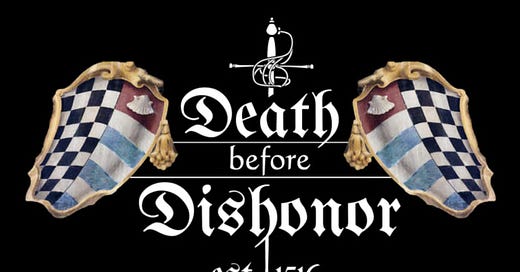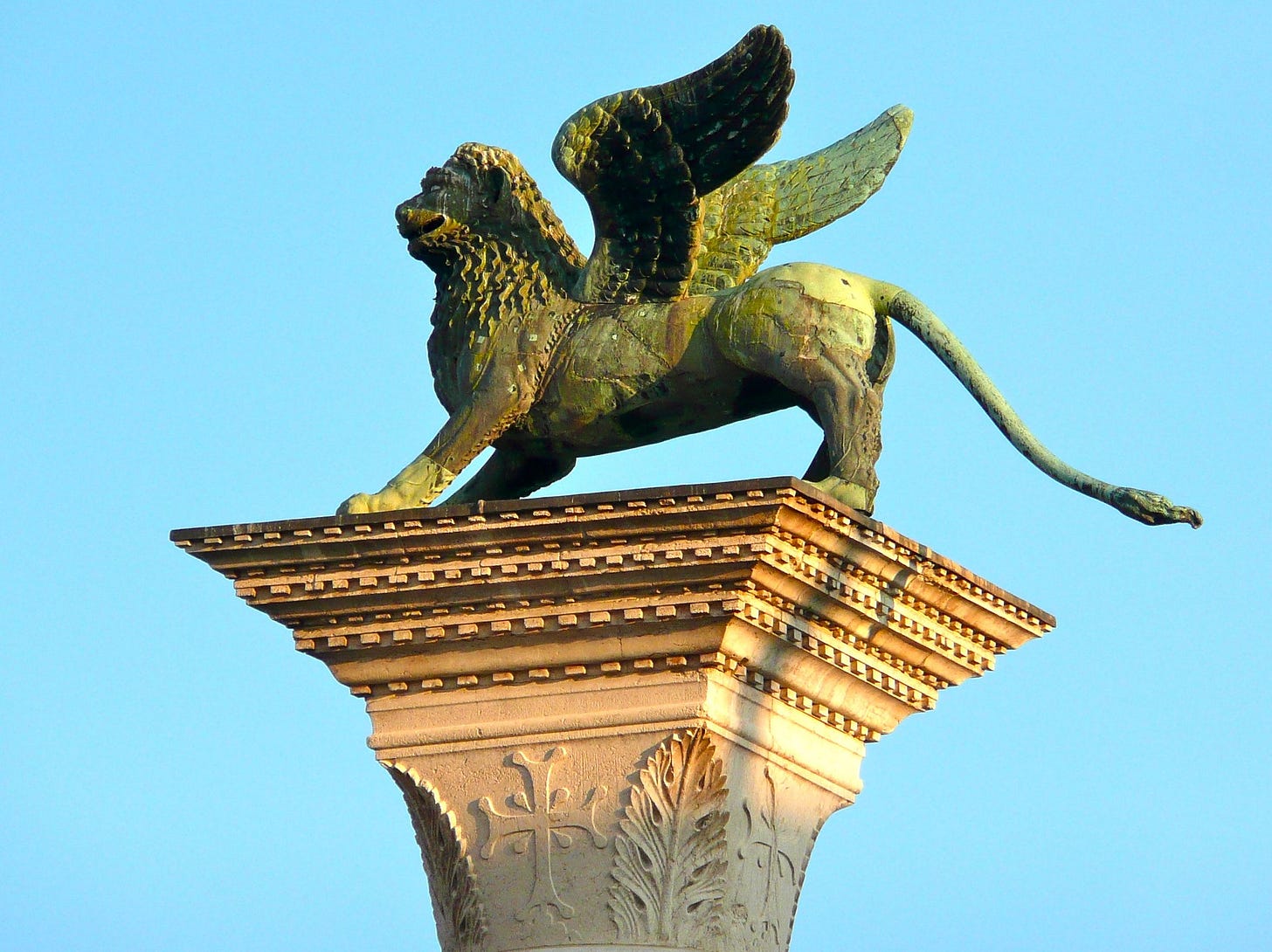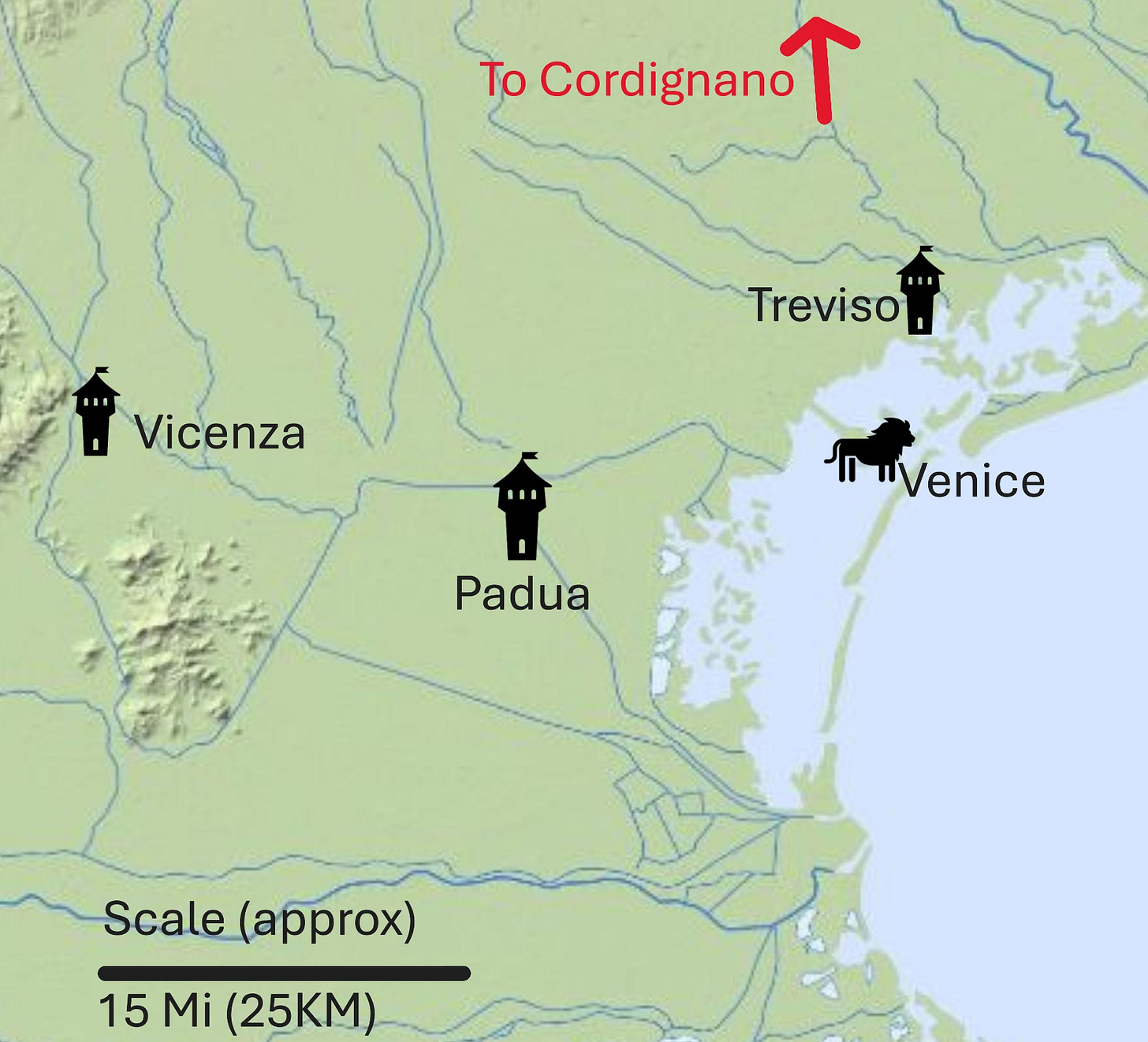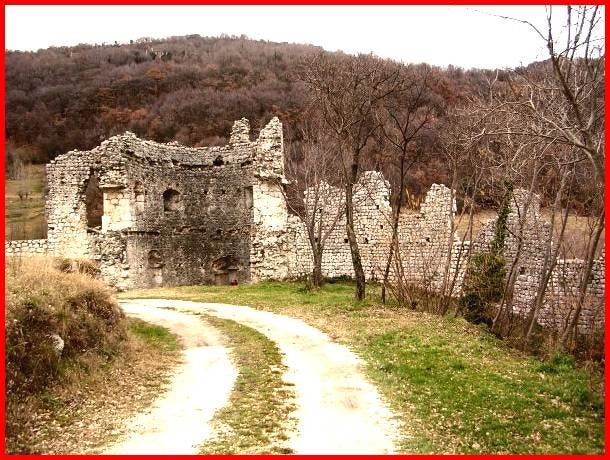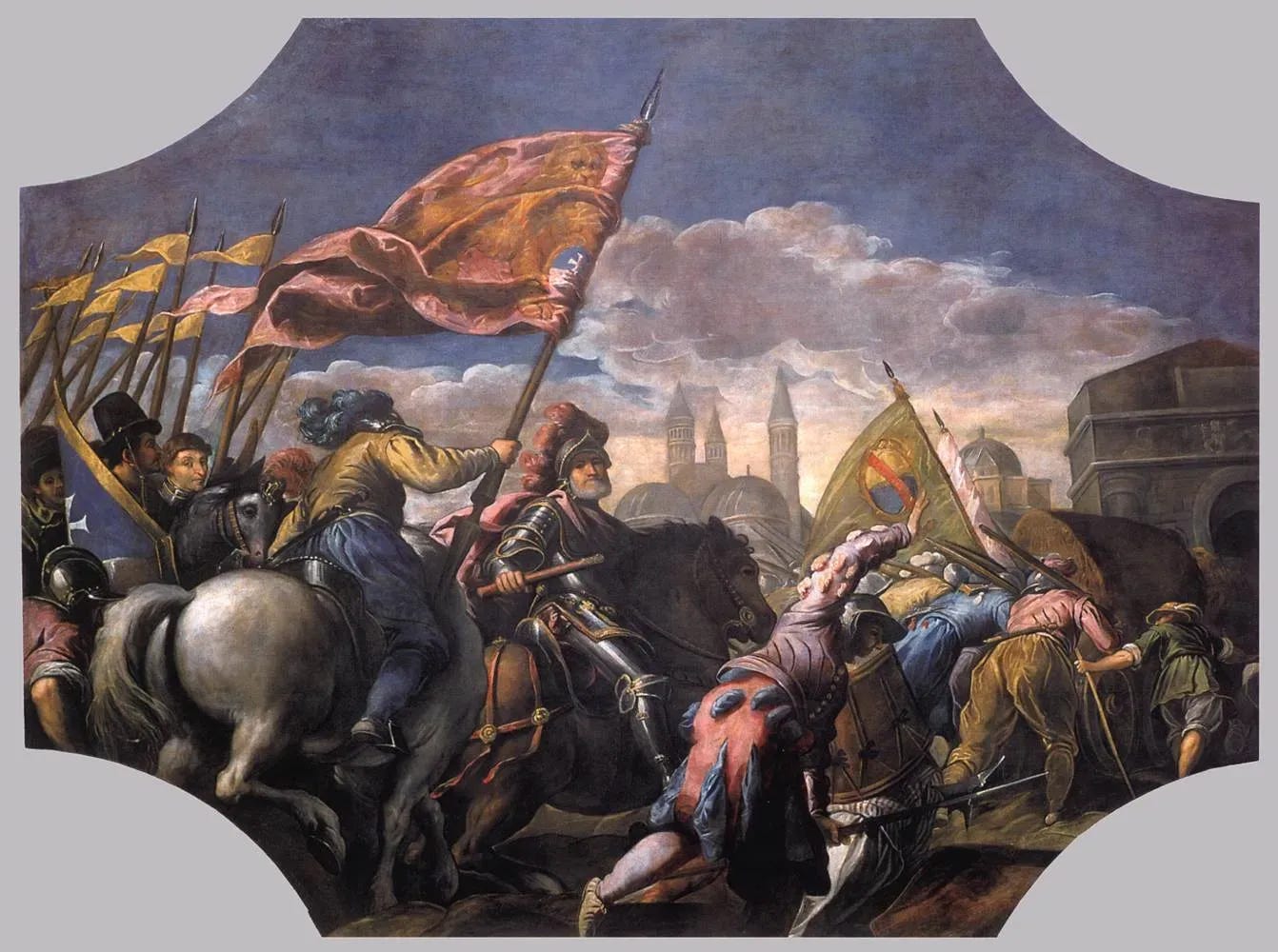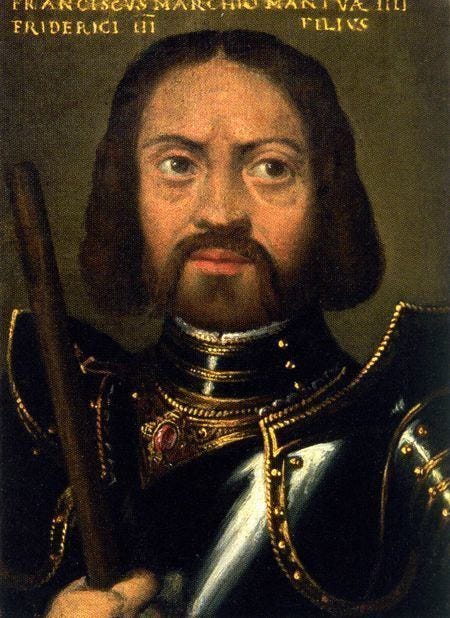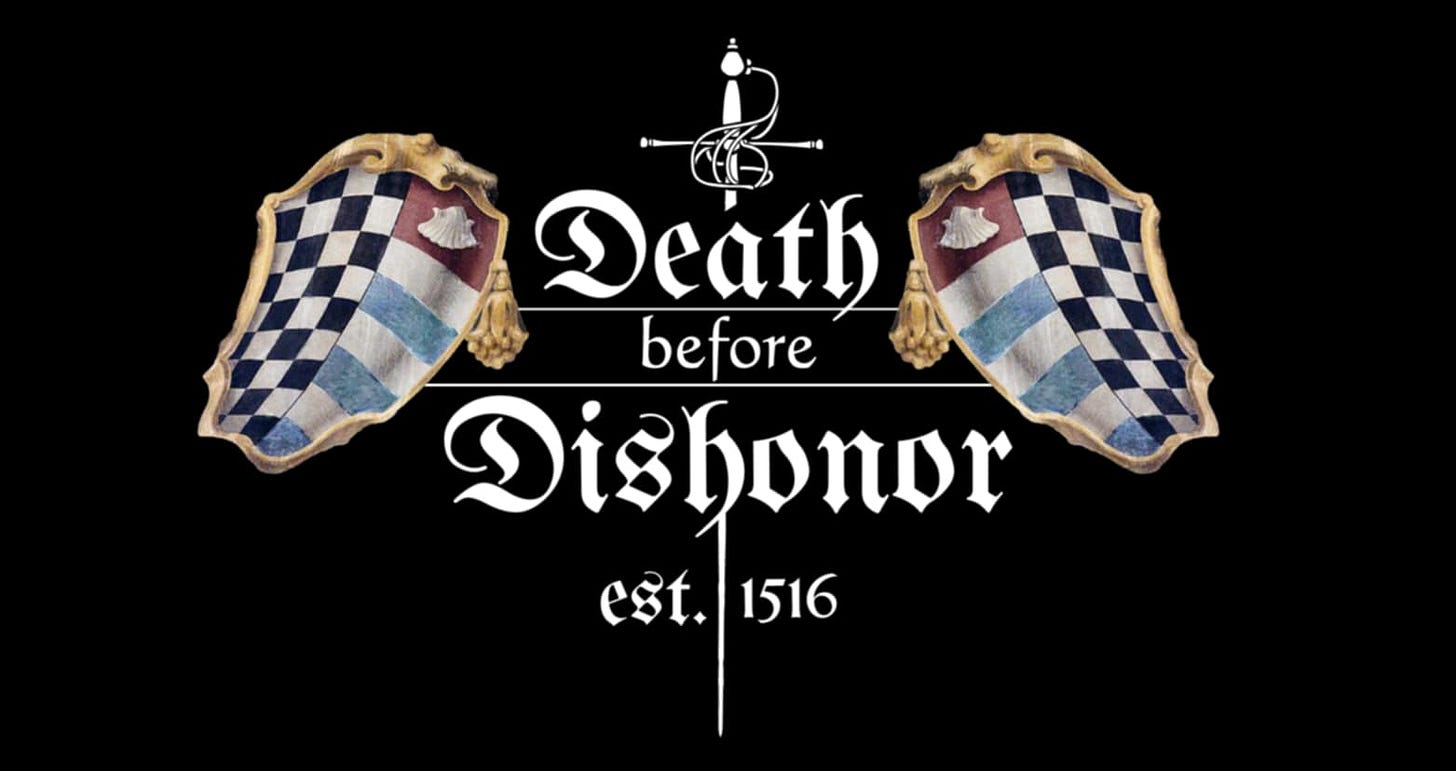June of 1509 found Guido Rangoni at his castle of Cordignano, balancing on a razor’s edge of indecision. Should he betray the past to secure his future? Until now, he had fought for Venice, his blood bound to the Bentivoglio cause. But after Venice’s terrible defeat at the hands of the French, the once-indomitable Republic of Venice was collapsing, its dominion washing away like a sandcastle swallowed by the tide.
Cordignano lay in the path of conquest, in lands now claimed by Emperor Maximilian. If Guido swore fealty, he could keep what was his. But if he chose defiance—if he dared to stand for Venice and lost—then Maximilian would seize Cordignano, just as the Duke of Ferrara had wrenched Spilamberto from his grasp when Guido risked all to restore his uncles to Bologna.
And yet—Maximilian was a German, an outsider. Sooner or later he would go back over the Alps. Venice, however, was eternal. Its power lay just forty miles away, and the Republic did not forgive betrayal. It remembered and waited for revenge. This castle—this very stone beneath his feet—had been a gift from Venice to his grandfather. How could he abandon them now?
But how could Venice possibly endure? France, the Holy Roman Empire, and half of Italy—all had closed in like wolves, and Venice’s proud armies were vanishing, melting like mist before the rising sun.
Guido was not alone in this cruel calculus. Across the Venetian mainland, soldiers, nobles, and landowners wavered, uncertain which flag would still be standing when the storm had passed.
And now, all eyes turned to Padua. Among all the cities of Venice’s Italian empire, none was more vital, none more decisive. In Padua, the fate of Venice—and the fate of men like Guido Rangoni—would be sealed.[1]
Leonardo Trissino
The Renaissance was an age of opportunity, where a man with determination—and a touch of luck—could carve his name into the annals of history. Leonardo Trissino was just such a man. Though he plays only a fleeting role in the life of Guido Rangoni, he is so perfectly emblematic of his time that he demands a closer look.
Born as a middle child into a middling family, nothing in Trissino’s early years hinted at the heights he would one day reach. By the age of thirty, he was a fugitive, fleeing the Republic of Venice to beat a murder rap. But fate and fortune smiled upon him, and his path led him to the court of Emperor Maximilian. There, Trissino’s athletic prowess and bold spirit left such an impression on the emperor that Maximilian himself knighted Trissino.
Then came the Battle of Agnadello. The Venetian army was shattered, and Trissino smelled blood in the water. He abandoned Germany and set his sights on his hometown of Vicenza. But he would not return alone. On his way, he gathered an army of “…colliers, and other bandits, and people of ill repute … all greasy, black, dirty, and tattered.” [2] With this lawless band behind him, he issued an ultimatum to Vicenza, warning of the emperor’s wrath. If they resisted he would bring, “fire and the sword to their country…sparing neither man, woman nor child…”
Abandoned by Venice, the people of Vicenza had little choice. They opened their gates to this ragtag force, and Trissino returned home in triumph.
Emboldened, he set his sights on a greater prize—Padua. This time, he left the bandits behind, taking only a small company of Vicentine adventurers and a hundred landsknechts. He rode toward the city garbed in the German fashion with his black velvet doublet lined with gold and a black German hat crowning his head. He had so fully embraced his new identity that people noticed scarcely spoke Italian anymore.[3]
Once again, the gates swung open. Once again, Trissino triumphed. Padua made him their lord.
With nothing but a handful of men, impeccable timing, and sheer audacity, Leonardo Trissino had transformed himself from a fugitive into a ruler. And soon, Emperor Maximilian would make it official—an Imperial count, not by birth, but by balls.
Guido Bends the Knee
Guido Rangoni’s path became painfully clear the moment Trissino captured Padua.
Realizing that if Venice could surrender such a critical city without even a fight, the Republic must truly be cooked, Guido Rangoni set out for Padua himself to pay homage to its new lord. In a pragmatic move, Guido offered to surrender his castle to Emperor Maximillian, pledging himself as a loyal follower—but only once the emperor’s army reached Cordignano.[4] Until then, Guido would not dare provoke the enduring wrath of Venice.
Around July 10th, the German forces finally arrived at Guido’s gates at Cordignano. Guido raised the white flag to welcome his new masters. Allowed to remain as lord of Cordignano, he now stood formally aligned against Venice.
Cordignano swiftly became the front line in the bitter war between Venice and the Germans. Though the Germans possessed greater strength, the Venetians were now driven by the ferocious resolve of those defending their very homes. Among the Venetian captains who arrived to challenge the German advance was the formidable Bolognese condottiere Lucius Malvezzi.1
Although no records survive of their conversation, Lucius almost certainly warned Guido he was making a grievous mistake in siding with the emperor—that Venice still held deadly plans in store for its enemies and was nowhere close to being out of the fight.
Though Malvezzi had commanded the Bologna garrison against Guido when Guido had tried to retake the city with his uncles, Malvezzi made it clear that a new enemy had emerged—Pope Julius and his despised minister, Cardinal Alidosi. The old rivalries between Malvezzi and the Bentivoglio were simply water under the bridge now.
As if to confirm Malvezzi’s words, the Venetians soon lured the German light cavalry into a deadly ambush, slaughtering fifty soldiers, capturing sixty prisoners, and leaving the enemy commander severely "wounded in the face by a warhammer."[5]
The Lion Roars Back
Venice knew the stakes. Padua, the jewel of their mainland empire, had to be retaken at all costs. Luckily for Venice, they had allies waiting inside the city itself and loyal peasants beyond its walls. Indeed, as one French soldier wrote, “no other lords were ever more loved by their subjects than the Venetians, solely because of the great justice they upheld.”[6]
Yet reclaiming Padua would not be easy. Desperate for manpower, Venice turned to its peasants beyond the walls, whose loyalty remained steadfast. They found cuirasses in the Arsenal and then sent them to arm the peasants.[7] Then, in an extraordinary measure, the Republic mobilized even the laborers from its mighty Arsenal—the very craftsmen whose skilled hands built the ships that dominated the seas. The men on whose labor the safety of Venice rested. These shipbuilders, armed hastily with “arquebuses, swords, halberds and partisans,” set off toward Padua by boat to cheers.
At precisely eight o’clock on the morning of July 17th, three wagons, laden heavily with wheat, rattled slowly toward the city gates.[8] Their arrival seemed innocent enough—simple provisions for the city. But as they reached the gate, one wagon suddenly jolted to a halt. By some “terrible” stroke of misfortune, its axle had snapped cleanly off, blocking the way right beneath the gate.
Paduan guards shouted furiously at the hapless driver, demanding he clear his cart. Yet the man, alone and helpless, made no progress. Before the guards could grasp the situation fully, their eyes caught sight of hundreds of mounted cavalry bearing down upon them—strattioti, fierce Greek mercenaries, “dressed in tunics and hats; with a lance in hand, or a mace, and a sword at their side.”[9]
Behind them came throngs of Venetian infantry.
The Venetian forces surged in through the open gate.
Leonardo Trissino bravely rallied his German defenders, battling furiously in the streets and squares. But the outcome was already decided. Within an hour, Venetian soldiers had pushed the German defenders into the citadel, where, cornered and exhausted, they quickly surrendered.[10]
Once more, the Lion of Venice hung on the ramparts of Padua: the city was Venetian again.
The Marquis of Mantua
The sudden recapture of Padua stunned many who believed Venice was already defeated and its fall a foregone conclusion. But for the Marquis of Mantua—future host of the duel between Hugo and Guido—the news came as a welcome surprise. Perhaps Venice was not finished after all. He had missed the Battle of Agnadello with a flare up of syphilis and now was his chance to redeem himself. He quickly raised an army and attacked the edges of Venetian territory.
Soon after, fortune seemed to smile upon him. A force of strattioti, those famed Greek cavalrymen, offered to defect from Venice and join his cause. On the night before their arrival, the Marquis confidently instructed his troops to admit these brave riders into their camp at dawn. Content with his plans, he retired to sleep, unaware of the calamity awaiting him.
That night the strattioti did set our for the camp of the Marquis. But they were not alone. Lucius Malvezzi was with them alongside a strong detachment of Venetian troops. As morning broke, the Marquis’s soldiers dutifully opened their camp to the incoming riders. Within moments, chaos erupted—it was a trap. With ruthless efficiency, Malvezzi and the Venetians overran the Marquis’s camp.
Oblivious to the disaster unfolding, the Marquis of Mantua slept soundly until the sudden cries and clashing weapons woke him. Panicked, he fled, only to be discovered hiding by two peasants in the fields nearby. Despite his desperate promise of a reward, these humble peasants betrayed him to his foes.
The Venetians seized the Marquis and quickly shipped him off as a prisoner to Venice. Venetian morale soared, invigorated by this dramatic victory.
In Rome, Pope Julius had been busy attempting to force an unfavorable peace upon Venice. When news of the Marquis’s capture reached him, he grasped immediately how deeply this setback would affect his plans. Furious, Julius understood exactly the significance of this reversal—so much so that he erupted in frustration, “ripping off his hat, throwing it on the ground and stomping on it.”
In La Serenissima’s Service
These fierce attacks by the Venetian lion were enough to convince Guido Rangoni to throw in his lot with Venice. On the 15th of August, he led 100 mounted crossbowmen out of his castle of Cordignano in Imperial territory and took them in the direction of Padua.[11] All armies were now converging on this critical city. As word of Guido’s movement circulated among the Bentivoglio camp, Bolognese men streamed to join his forces.
On the day that Guido Rangoni left Cordignano, the main Imperial camp was less than five miles north of Padua. But the Germans were not the only ones threatening Padua. Here too was a powerful force of French cavalry that roamed freely through the countryside, “defacing and plundering at will.”[12]
As Guido led his men to Padua he had to dodge past these hostile enemy forces. Enemy riders ringed the city and Guido could not find a way to safely make it through to the garrison. At least, not at first.
But the garrison of Padua was not just sitting idly by and letting themselves be ringed in by the enemy. They were constantly send cavalry raids against the besiegers.
Guido soon came across one of these raiding forces from inside the city and joined forces with them. Together they captured some “eighteen enemy men-at-arms and many infantry.”
Then they rode hard for the city of Padua and set the garrison to edge by shouting “To arms! To arms!” as they approached. They rode in through the eastern gate of the city to the jubilation of the garrison, happy at the sight of enemy prisoners and fresh reinforcements.
Not only had Guido made it through a cordon of enemy patrols, the 100 mounted crossbowmen he had possessed when he left Cordignano now numbered 200 men, all spic and span, or “in good order,” as his Venetian inspector declared.[13]
Guido was just in the nick of time, for the besiegers planned to begin their assault on the walls of Padua in three days’ time.
The stage was now set for the fateful Siege of Padua.
[1] In a fitting bit of irony, the original city of Venice was founded by refugees from Padua during the fall of the Western Roman Empire.
[2] Trissino, p.17
[3] Considering the time and location this would not be Tuscan-Italian, but rather a Lombardic dialect largely understandable from place to place across Northern Italy, as described in Castiglione’s “Courtier.”
[4] It would not be until July 10th that Sanudo would note the surrender of Cordignano to the Emperor, three weeks after da Porto confirms the investiture. Da Porto, p.84.
[5] Sanudo, col. 514. The text is a little vague on this account. It could be he is just wounded. Curiously, the wound with the warhammer is described as a “stoccata” or thrust.
[6] De Mailles, p.146
[7] Sanudo, col. 499.
[8] Note that this story varies between authors. The Venetian diarist Girolamo Priuli has the wagons carrying iron. Perhaps the most accurate is that of Luigi da Porto on p.100 described it in a letter. Guicciardini describes it on p.745, but his account differs from those alive and proximate to Padua at the time.
[9] Sanudo, Expedition of Charles VIII, p.313
[10] Da Porto, p.101.
[11] Sanudo, Vol IX, col.65
[12] The Good Knight, Samuel Shellaberger.
[13] Sanudo, Vol IX, col.87
Note this is suppositional. Malvezzi was within five or so miles of Guido’s castle and based on future events it seems likely that the two men met.

